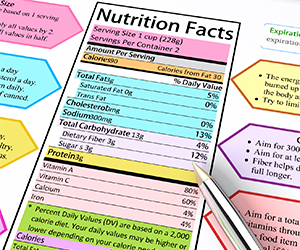
The FDA recently unveiled it’s updated version of the Nutrition Facts panel, the label on the back of packaged goods that lists macro- and micro- nutrients. Several changes have been made since the last version was released in 1994. We highlight the changes below and how they may impact bariatric patients.
- The total calories will be made more prominent
New larger, bolder print will be set for the calories, making it easier to see. This is key for gastric sleeve, gastric bypass, and lap band patients. Paying more attention to the calories consumed will help you budget your overall calories to get the most nutrition into your reduced calorie diet.
- Serving sizes will more accurately reflect the servings actually eaten.
A 20 ounce soda will now list the calories in the whole container as it is assumed the entire bottle with be consumed. Serving sizes will reflect the amount typically eaten instead of a size chosen by the manufacturer. This will help show bariatric patients a more accurate calorie count for the foods you are choosing, enabling you to make wiser decisions for your health and weight loss.
- Declaration of ‘grams’ and a percent daily value (%DV) for ‘added sugars.’
This is a controversial section of the new label. Total carbohydrates now includes a line for added sugars as part of the total sugars, and in addition to dietary fiber. Food manufacturers pushed back against including ‘added sugars’ on the label, claiming the public would not understand that the added sugar was included in the total sugar. Others have argued that sugar is sugar no matter if it’s added or naturally occurring, and does not warrant it’s own line on the nutrition label. In the end, ‘added sugar’ is included and can clue consumers into foods that have been sweetened as opposed to the sugars naturally occurring in foods such as fruit and dairy. This is a big one for anyone watching their sugar intake, whether for weight loss purposes like gastric sleeve, gastric bypass, or lap band patients, or those watching their sugar intake for other health reasons. Looking at the ‘added sugar’ of some items will be an eye opener, especially for some items, like yogurt which have both naturally occurring sugars from the milk, and then added sugars to sweeten the yogurt.
- Updated values for sodium and dietary fiber
The recommended intake for sodium and dietary fiber are changing, which will alter the %DV listed on the package. The food item may have the exact same number of grams as it previously did, but the percentage may change. Recommended amounts for fiber will increase, and sodium will decrease.
- Dual columns for ‘per serving’ and ‘per package’ for multi-serve packages.
If an item is a size that offers multiple servings, but could be consumed in a single sitting (think: bag of chips, or pint of ice cream), the label will show both the nutrition facts for the single serving and the entire container. This should prove to be very helpful to those who are trying to lose weight. In case you didn’t catch the number of servings in the package and didn’t multiply the calories times the number of servings, this new information should clue you into the total calories you will consume if you eat the whole thing.
- Vitamin D and potassium replace Vitamins A and C
Not only will vitamin A and C values be replaced by vitamin D and potassium, but those will also now be displayed in both grams and %DV. The theory here is that the public at large gets enough vitamins A and C, but many are still not meeting the recommended doses for vitamin D and potassium. By adding these nutrients to the label, consumers will hopefully be more mindful of the amounts of vitamin D and potassium they are receiving and strive to meet recommended doses.
- Calories from fat removed from label
As research shows, the type of fat is more important than the calories from fat, so this line will be removed. Total fat, saturated fat, and trans fat will all remain.
- A new footnote better explains Daily Value
New wording aims to better explain daily value to the public.
Look for the revised Nutrition Labels to make their debut in two years. A big push will be made to educate the public as to the changes and how to read the new labels. The changes that will be made should be helpful to gastric sleeve, gastric bypass, and adjustable lap band patients, so we encourage our bariatric patients to receive the new Nutrition Labels with an open mind. In the meantime, keep reading current Nutrition Labels and pay particular attention to calories, saturated fat, and total sugars and try to make the best choices for reducing those numbers while increasing dietary fiber.
The above information is offered by Dr. Shillingford, M.D., P.A., a board certified surgeon specializing in advanced laparoscopic and obesity surgery. Dr. Shillingford’s gastric sleeve, gastric bypass, and adjustable lap band patients come from all over South Florida, including Boca Raton, Delray Beach, Wellington, Miami, Coral Springs, and West Palm Beach. His bariatric patients are often interested in information that will assist them in their weight loss efforts.

 Am I A Candidate
Am I A Candidate  BMI Calculator
BMI Calculator  Why Choose Us
Why Choose Us